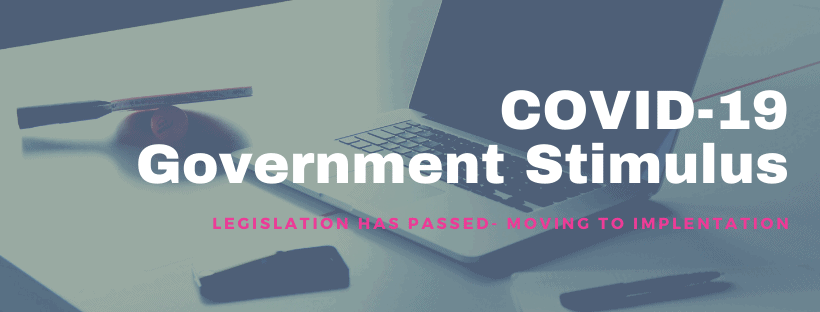Late on Wednesday, 8 April 2020, Parliament passed the Coronavirus Economic Response Package (Payments and Benefits) Bill 2020 and the Coronavirus Economic Response Package Omnibus (Measures No. 2) Bill 2020.
The first of these measures authorises the introduction of the “JobKeeper” scheme, which will provide wage subsidies of $1500 per fortnight for up to 6 million workers whose jobs and income have been affected by COVID-19 and the measures taken to contain its spread. The Bill itself does not contain the JobKeeper measure, however it provides the Treasurer with the power to make Rules in relation to payments and benefits in response to the Coronavirus pandemic.
The second, among other changes, amends the Fair Work Act 2009 (Cth) (the FW Act) to give employers who are eligible for JobKeeper support greater flexibility to manage employees’ hours, location and duties without their consent. It also allows those employers to more readily reach agreement with employees on the taking of annual leave.
As you are aware, JobKeeper payments are payable to qualifying employers for a maximum of 13 fortnights in respect of each eligible employee on their books on 1 March 2020 who is retained by the employer. Qualifying employers will receive a payment of $1500 per fortnight for each eligible employee. They are required to pass on all of this payment to Eligible Employees in order to guarantee a minimum $1500 of payment for each Eligible Employee.
There have been some further details released on some of the eligibility criteria and how the timing payments work. They are detailed in various fact sheets issued by the ATO. Below is a brief outline of some of the key points at this time:
The Treasurer will be able to make rules that allow the ATO to make JobKeeper Payments to eligible entities, and the Tax Commissioner will have general administration of these payments. The framework sets out the way in which payments are made, rules for over payments (including the application of interest), the process for the review of decisions about payments and record-keeping requirements. The details of eligibility for payments, as well as the amount of payments and the time when they are to be paid, will be set out in the rules made by the Treasurer, so that arrangements can be modified appropriately in response to impacts of COVID-19.
The Coronavirus Economic Response Package (Payments and Benefits) Rules 2020 Exposure Draft (the Rules) provided further details of how the Treasurer intends to set the JobKeeper rules. This includes specifying that the JobKeeper scheme starts on 30 March 2020 and ends on 27 September 2020, although the Bill allows for a period up to the 31 December 2020. At the time of writing, the Legislative Instrument has not been released and may be different in its final form.
Decline in turnover
If an entity’s (including sole trader) aggregated turnover for the income year is less than $1 billion dollars then a 30 per cent decline in turnover is required to be eligible for JobKeeper payments. For ACNC-registered charities, the threshold is 15 percent while it is 5 percent for entities with a turnover of $1 billion dollars or more.
The business’s GST turnover, with some modifications, will be used to calculate the actual drop in turnover percentage. The turnover test period must be:
- a calendar month that ends after 30 March 2020 and before 1 October 2020; or
- a quarter that starts on 1 April 2020 or 1 July 2020; and
- the relevant comparison period must be the period in 2019 that corresponds to the turnover test period.
Treasury clarified that the Tax Commissioner will have the discretion to determine that a business qualifies for the payments, even if for some reason the business is unable to satisfy the stipulated criteria of reduced turnover. The ATO can consider additional factors put forward to demonstrate a business has been impacted such as where the business was not operating a year before, or if the previous year’s turnover was not representative of its usual turnover. Alternative tests to satisfy the criteria in certain circumstances may also be provided by the Commissioner, for example, if a business has ceased or its operations have significantly reduced.
As the applications will require employers to make an estimate about expected fall in turnover, Treasury has advised there will be some tolerance if the actual fall is slightly smaller than that estimated by the employer.
Access to JobKeeper for nominated eligible business participant
JobKeeper also addresses the lack of access to the Cash Flow Boost by business owners operating as sole traders or through partnerships, companies or trusts and not drawing wages. The Rule provides for payments to sole traders as long as they do not receive JobKeeper from another source, as well as the ability to nominate a single individual beneficiary of a trust, a single partner in a partnership, or a single director or shareholder of a company to receive JobKeeper, subject to the eligible business participant test. These businesses will also receive JobKeeper payments for their eligible employees.
To be eligible a business must have had a registered ABN as at 12/03/2020 and were carrying on a business in Australia. The ‘business’ must have had an assessable income in the 2018-19 income year and the ATO must have had must before 12/03/2020 by way of income tax return or activity statement of this assessable income. Alternatively if your ‘business’ does not meet this criteria it must have made a taxable supply between 01/07/2018 and 12/03/2020 and reported this to the ATO by way of Activity Statement of that taxable supply.
Eligible Employees
This is a one in all in scheme and this rule is a key feature. This means employers are not able to select specific employees to claim this for. Employees must meet the following criteria
- Employed by the entity at any time in the fortnight
- As of 1st March 2020
- Aged 16 years or over, and
- Australian Resident including those who are residents for the purposes of the Income Tax Assessment Act 1936 and holding the special class visa subclass 444
- A Full time or Part Time Employee of the business
- A long term casual employee (regular and systematic basis during the period of the previous 12 month
- Must have complete the nomination notice (acknowledgement of employer in receipt of JK)
Nomination and notification
The employer must notify the Tax Commissioner that they have elected to participate in the JobKeeper scheme by the end of the second JobKeeper fortnight for an entitlement arising in the first or second JobKeeper fortnight, or by the end of the fortnight for an entitlement arising in any other fortnight.
The employer must also notify an eligible employee or eligible business participant in writing within seven days of notifying the Tax Commissioner of their details. Such an individual must agree to be nominated by the employer or business.
Further, an employer cannot be entitled to a JobKeeper payment for an individual if another entity is entitled to a JobKeeper payment for the individual.
Payments to eligible employees or eligible business participants should be made via payroll systems and reported to the ATO via Single Touch Payroll. This will support the online claim process when it is available. If Single Touch Payroll reporting is not yet in place, JobKeeper payments will be claimed through a manual process.
Administration and ATO Reporting
The Tax Commissioner will pay the JobKeeper payment 14 days after either the end of the calendar month in which the fortnight ends (that is, monthly in arrears) or when the Tax Commissioner is satisfied the entity is entitled.
An entity that has qualified for the JobKeeper scheme must notify the Tax Commissioner within seven days of the end of a calendar month (the reporting month) if the entity is entitled to a JobKeeper payment for a fortnight that ends in the month, by reporting:
- the entity’s current GST turnover for the reporting month.
- the entity’s projected GST turnover for the following month.
Payroll Processing
JobKeeper payments will be processed through your normal payroll system. There will be requirements for additional allowances and categories to be set up in order to ensure correct reporting takes place.
ATO has advised that the first fortnight and second fortnight will be eligible for the stimulus providing it has been paid prior to the end of April 2020. This means you can pay fortnight 1 (30/03/2020-12/04/2020) and fortnight 2 (13/04/2020 to 26/04/2020) as one payment provided you complete this prior to 30/04/2020.
PAYG withholding and superannuation
Payments made to employees are taxable and PAYG amounts should be withheld. Superannuation is payable on the remuneration paid for hours worked. Where an employee’s wages are topped up to the $1500.00 per fortnight, it will be at the employers discretion whether there is superannuation paid on these top up amounts.
Record-keeping obligations
Records must be kept substantiating eligibility and payment claims. Failure to do so will dis-entitle the entity from receiving payments, and the ATO will be able to claw-back payments already made. The ATO has been given the power to issue guidance about the form and contents of records that must be kept.
Integrity provisions
The legislation contains specific integrity provisions including joint and several liability for over payment of debts. The existing administrative penalties and tax and criminal offence provisions will also apply.
Tax secrecy
Schedule 7 of the Omnibus Bill No 2 makes amendments to the tax secrecy provisions in the TAA 1953 to allow de-identified protected information to be disclosed to the Treasury for the purposes of policy development, or analysis, in relation to COVID-19, including in relation to programs introduced in response to the economic impacts of the COVID-19. The amendments allow such disclosures to be made until 30 June 2023.
Practical considerations
As previously announced by Treasury, the Commissioner of Taxation will be given certain discretion relating to the operation of the Scheme, including the ability to provide alternative turnover tests that can be satisfied if the tests already announced by Treasury cannot be met. It is anticipated that the ATO will make this information available once Treasury has released the Rules.
We expect that there will be further guidance on eligible employers, eligible employees and the business participant test. We believe this information is imminent and as soon as it is available, we will be working quickly to provide you with all the information you need to assist you during these uncertain times.
We will running another Webinar on Friday 17th April 2020, at 3.30pm, please join us by clicking on the link below to register your attendance.





